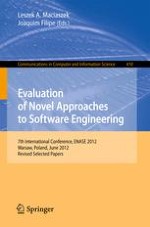2013 | Buch
Evaluation of Novel Approaches to Software Engineering
7th International Conference, ENASE 2012, Warsaw, Poland, June 29-30, 2012, Revised Selected Papers
herausgegeben von: Leszek A. Maciaszek, Joaquim Filipe
Verlag: Springer Berlin Heidelberg
Buchreihe : Communications in Computer and Information Science
